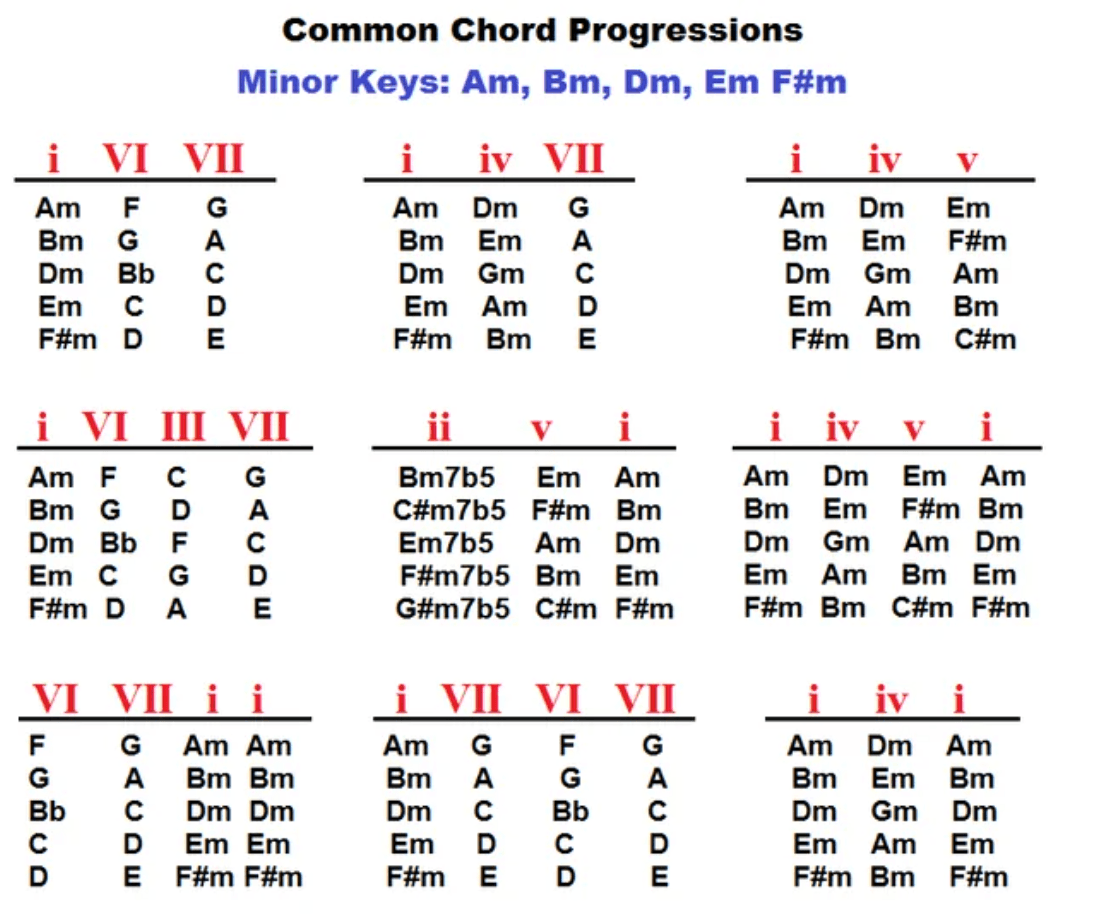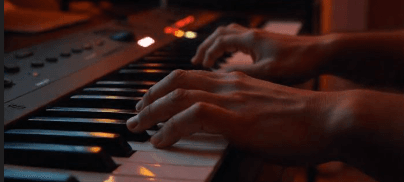The fascinating world of chord AI is redefining how we approach music creation, and it’s about time you got the lowdown.
Whether you're a budding musician or an established artist, AI tools like Empress are making it easier than ever to bring your creative visions to life.
Keep reading, because you don’t want to miss what we’re about to share!

What Are AI Chord Generators and How Do They Work: A Deep Dive into Your New Audio Production Best Friend
Feeling stuck with your chord progressions and hitting a creative roadblock?
Musicians of all experience levels frequently encounter this challenge.
But hold that thought—enter AI chord generators, the game-changing audio production tool you didn't know you needed.
The Mechanism Behind AI Chord Generators
So, how exactly do these remarkable tools function?
AI chord generators employ artificial intelligence algorithms that sift through an extensive database of songs.
These are songs that span a multitude of genres, moods, and eras.
The algorithms analyze the chord structures, tempo, and bars in these songs to understand the musical patterns that make a song a particular genre or mood.
Once you input your preferences—like the instrument you're using, the key you want to play in, the genre, and even the beats per minute (bpm)—the AI algorithm goes to work.
It processes the historical data and applies statistical analysis to generate a chord sequence tailored just for you.
The Special Ingredient: Real-Time Adaptation
What sets these generators apart is their ability to adapt in real-time.
As the AI algorithms continue to learn and improve, your generated chords become more accurate and aligned with current musical trends.
This is a far cry from traditional chord generators that use preset midi files and offer a one-size-fits-all approach.
The User Experience: As Simple As It Gets
The user interface is often so straightforward that even if you're not tech-savvy, you can generate chords in a snap.
Simply input your instrument, choose your key, select the genre, and specify the bpm. After that, most generators will allow you to download your sequence in various formats, such as wav, pdf, or mp3.
Time-Efficiency: The Unseen Perk
Perhaps the most fantastic aspect of using an AI chord generator is the time it saves.
What might take you hours of experimenting, erasing, and retrying can now be accomplished in mere seconds. I
t's not about replacing the musician's role in audio production; it's about enhancing it.
The Final Product: More Than Just Chords
While the focus here is on generating chords, many of these audio AI tools can also assist in creating lyrics, beats, and even entire song structures.
It's like having a virtual bandmate who's there to provide inspiration when you're stuck.
AI chord generators are not just another tool in your audio production toolkit; they're your collaborators, ones that bring you closer to actualizing your musical vision.
A Deeper Dive into Empress' Chord Candy: Your Go-To AI Music Tool for Tailored Chord Sequences
In the world of AI music tools, Empress' Chord Candy stands out as an indispensable asset for both seasoned musicians and newcomers.
With its intuitive interface and powerful capabilities, this AI-driven marvel offers you a helping hand in chord generation. But what exactly sets it apart?
Let's delve deeper.
The Basic User Journey: Getting Started is a Breeze
Getting started with Chord Candy is incredibly straightforward.
You'll be greeted by a sleek user interface where you can input your instrument, key, genre, and bpm (beats per minute).
Once you hit "Generate," Chord Candy gets to work, employing complex artificial intelligence algorithms to craft a chord sequence tailored to your specifications.
Customization at Its Finest: The Scenarios
For a practical example, imagine you're an up-and-coming jazz enthusiast with a passion for the piano.
You input your instrument as the piano, set the key to C Major, opt for the jazz genre, and dial in a tempo of 100 bpm.
What you get is not just any chord sequence, but one designed to align with the hallmarks of jazz.
For example, Chord Candy might churn out a 12-bar blues pattern, a chord progression deeply rooted in jazz compositions.
Bridging Musical Knowledge Gaps: More Than a Chord Generator
What elevates Chord Candy from a mere chord generator is its educational aspect.
You're not just provided with a chord sequence; you'll also receive insightful commentary on why these particular chords fit together and how they align with the genre you've chosen.
This makes it a phenomenal learning tool for understanding chord progressions and their role in different musical styles.
A Must-Have for Creativity
Chord Candy is far more than a one-trick pony - it's an AI music tool that offers a blend of convenience, customization, and educational value.
Whether you're a seasoned pro or just dipping your toes into the ocean of music composition,
Chord Candy serves as a reliable partner, turning your creative visions into structured, beautiful realities.

Why AI Matters in Music and Education: More Than Just a Trend
The emergence of artificial intelligence in the realm of music education isn't just about pushing boundaries; it's also about tearing down walls that often separate people from their creative potential.
In today's technologically advanced world, tools like Empress and chordchord offer invaluable opportunities for both learning and creation. Let's explore why.
Empress: The Comprehensive AI Music Tool for All
Empress has set a high bar in the AI music tool landscape, offering a wide range of features from chord generation to lyrics and melody crafting.
It's a resource that professional musicians often turn to for inspiration, but it also holds substantial educational value.
Empress offers real-time feedback and educational insights, making it easier for students or newcomers to understand complex musical theories.
chordchord: An Easy-to-Use Visual Guide for Beginners
What makes chordchord great for learners is its incredibly intuitive interface. For those who are just starting their musical journey, chordchord displays chords visually and even helps guide the rhythm.
By simplifying complex structures into digestible visual components, it makes the learning process much more accessible.
The Educational Synergy: Melding Theory and Practice
While traditional music education often segregates theory and practice, AI music tools like Empress and chordchord offer a synergistic approach.
By using these tools, students can immediately apply theoretical concepts in a practical, real-world setting, thereby solidifying their understanding and retention.
This is an enormous leap forward in audio production education, aligning closely with the way our brains are wired to learn—through doing.
A Broader Reach: Making Music Education Inclusive
Integrating AI into music education has a transformative effect, especially in terms of making it more inclusive.
Conventional music training often comes with a hefty price tag and demands a considerable time commitment.
AI music tools level the playing field by providing affordable, readily accessible resources to anyone with an internet connection.
This democratizes access to quality music education, opening doors for a broader range of people to explore their musical interests.
The Future is Bright and Harmonious
Artificial Intelligence in music and education isn't just a luxury; it's fast becoming a necessity.
By offering a blend of creativity and educational insights, tools like Empress and chordchord are paving the way for a more inclusive, innovative, and effective learning landscape.
So whether you're a seasoned musician looking to refine your skills or a beginner eager to hit the right notes, AI is here to elevate your musical journey.
The Backbone of Every Song: Why Chords Are Indispensable
When it comes to audio production, we often get caught up in the beats, the lyrics, or the flashy guitar solos.
But what holds all these elements together and gives a song its soul?
It's the chords. Acting as the structural backbone of a song, chords do far more than just add musical depth.
They shape the entire emotional and thematic landscape of a composition.
The Architecture of Emotion: Setting the Tone
Before a single lyric is sung or a drum beat is dropped, chords introduce the emotional framework of a song.
From melancholic minor chords to uplifting majors, they offer a sonic palette of feelings.
By setting the tone, chords provide a rich emotional backdrop that amplifies the impact of every other musical element, from lyrics to tempo.
This is akin to setting up the stage lights before a theatre performance; the mood is established before the action begins.
Giving Depth to Lyrics: A Harmonic Paintbrush
If lyrics are the words in a song's story, then chords are the tone of voice. A change in chord progression can make the same lyric line go from hopeful to heart-wrenching, from relaxed to urgent.
Chords give words their emotional color, imbuing them with richer meanings that resonate deeply with the listener.
This is particularly crucial for songwriters who use their compositions as a form of self-expression.
Genre Signatures: Setting Audience Expectations
Chords aren't just emotional; they're also cultural and genre-defining. Certain chord progressions and rhythms are iconic to specific styles of music, be it jazz, country, or rock.
These signature chords help set audience expectations and form part of the musical identity of a genre.
For instance, a 12-bar blues progression will immediately signal to the audience that they're in for a soulful, earthy experience.
A Guiding Structure: The Blueprint of a Song
At its core, a song is a form of storytelling, and every good story needs a solid structure.
Chords offer a predictable yet flexible framework, allowing for variations and surprises while keeping the listener engaged. They guide us from the introduction to the climax and finally to the resolution, like chapters in a book or scenes in a movie.
Chords are essentially the bars and structure upon which the entire composition hangs.
A Shared Language: The Universal Impact of Chords
In a world of diverse musical tastes and ever-expanding genres, chords serve as a universal language.
They are the essential building blocks understood by musicians worldwide, transcending linguistic and cultural barriers.
This makes them one of the most potent tools in a musician's arsenal for creating songs that can touch hearts globally.

Essential Chord Progressions Every Musician Needs to Master: A Quick Guide for Novices and Experienced Musicians Alike
Whether you're a seasoned musician or a newcomer to audio production, mastering chord progressions is essential for creating emotionally resonant and structurally sound songs.
Chord sequences serve as the foundational elements that direct a song's emotional and rhythmic trajectory.
Here are seven essential chord progressions you should know, regardless of your genre.
1. The Most Popular Kid on the Block: I-V-vi-IV
Let's kick things off with the I-V-vi-IV progression.
Sometimes called “the most popular progression,” it’s widely used in everything from country to post-punk.
Why? Because it's incredibly versatile.
Each chord in the sequence feels like a fresh emotional statement. It's as if you're telling an engaging story where every sentence packs a punch.
Familiar songs that use this progression range from pop hits like "Let It Go" by James Bay to iconic rock anthems like "With or Without You" by U2.
2. The Pillars of Harmony: I, IV and V
Up next, we have the I, IV, and V chords.
These are the fundamental pillars for chord progressions in nearly every style of popular music.
They represent the simplest versions of the three main categories in tonal music—tonic, pre-dominant, and dominant.
The sense of tension and release generated by moving from one to another provides the chord progression with its forward momentum.
This progression is often heard in blues, rock, and even reggae, and it's remarkably accurate in delivering a sense of musical completion.
3. Jazz It Up: ii-V-I
If you're into jazz or any of its offshoots like R&B, neo-soul, or even some types of hip-hop, the ii-V-I progression is your bread and butter.
It's the backbone of almost all standard tunes in jazz and provides that ineffable “jazzy” feel.
You’ll often find this progression used in songs that have a complex or refined harmonic structure.
4. A Touch of Blues: 12 Bar Blues
One of the most iconic chord progressions in music history, the 12 Bar Blues is the quintessential blues progression.
However, it’s so versatile that you'll also find it in rock, jazz, and even country.
Its structure offers a sense of melancholy, soulfulness, and sometimes, paradoxically, joy.
5. Romance in the Air: I-vi-IV-V
This progression is frequently used in the classic love songs and doo-wop tunes of the '50s. However, its appeal is timeless.
The smooth transition from the tonic to the sixth offers a great blank canvas for vocal melodies and creates an emotionally compelling arc.
6. From Aisle to Stage: Canon
The Canon progression is a revered sequence in classical music, often heard at formal occasions like weddings.
But it's also surprisingly versatile, popping up in various genres.
It moves through different chords in the key before gracefully circling back to the tonic. Songs like Vitamin C’s “Graduation” or Belle and Sebastian’s “Get Me Away from Here I’m Dying” are excellent examples.
7. Rock Your World: I-bVII-I
Last but not least, the I-bVII-I progression is a staple in rock and pop music.
It's simple but effective, providing just enough harmonic action to keep a song intriguing.
This progression often incorporates the bVII chord from the natural minor scale, adding a pleasing, sometimes unexpected color to the music.
It’s commonly associated with the Mixolydian mode, which is frequent in rock tunes.
Unleash Your Creative Potential with Empress Today!
Ready to take your music creation to the next level? Use Empress, your ultimate audio AI tool, and never worry about hitting a creative wall again!
FAQs: Chord AI Generator
Can AI Generate an Entire Song?
While audio AI tools like Empress can help with chord progressions, beats, and lyrics, they are aids in the creative process, not replacements.
Is Chord AI Accurate?
Most chord AI tools, including Empress, offer accurate and reliable suggestions for chord progressions.
Q3: How Can I Export the Generated Music?
Most AI chord generators allows you to export in various formats including wav, pdf, and mp3.
Q4: What About Generating Lyrics?
Yes, in addition to chord generators, Empress can also help you with lyrics.
Q5: Can I Create a Custom Tempo and Structure?
Absolutely. Empress lets you set custom tempo, bars, and even offers midi export options.
Follow the future of music with Empress. Check out our blog to learn how you can effectively use these AI music tools.


